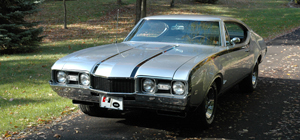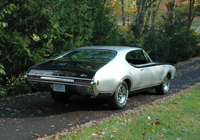


From 442.com FAQ:
Remember though folks, the 455's were installed on the factory assembly lines in the H/O's, contrary to what you may have heard. According to Doc Watson, a story was made up about the 455's being installed at Demmer. Nope. That was just to keep the Olds brass happy with their ban. The cars were driven off the assembly line. An old Olds engineer has pics of the plain white '69 non-emblemed 442's on their way out the Lansing door. Makes sense, since the assembly manual references W-46 codes in the engine section, and Federal law said the engines had to have part of the VIN stamped into them when they left the factory. So, unless that was a 455 block that "got away," it should have had a 400. Anything was possible back then, however.
From HOCA website:
In 1968, GM had a corporate edict that forbade the installation of any engine larger than 400 cubic inches in an intermediate body. Thus, the 442 had a 400, the Chevelle a 396 and the GTO a 389. Shifter mogul George Hurst had a '68 442 that he had swapped an Olds 455 into, and found the swap to be not only successful, but relatively simple. Not only was there an increase in power, but the 455 actually weighed less then the 400 it replaced, so the 442's legendary handling remained intact. George's right-hand man, Jack "Doc" Watson, took the idea of the engine swap a few steps further, adding special paint, a Hurst shifter, engine modifications, and a walnut dash applique, and the Hurst/Olds was born.
The first Hurst/Olds was almost a sleeper. Sedate looking in its silver and black paint scheme, it was far from sedate acting with 390 horsepower nestling under the hood. Based on the already potent 442, the H/O featured a special Toronado-only paint color, Peruvian silver, accented with black stripes and a black trunk. The 442's 400 was replaced with a hot-rodded 455 from the Toronado, which featured big-valve heads, lumpy cam, specially modified carb and distributor, and the W30's ram air induction system, with twin scoops under the front bumper. Air conditioned cars lost 10 horsepower, but still, the "gentleman's hot rod" was able to show its taillights to most competitors. A unique feature found on the '68 was the red plastic inner fender liners, which were slipped into the package by Olds boss John Beltz. On the inside, the '68 featured a walnut inlay on the dash panel and a short plastic console that housed the Hurst Dual Gate shifter. Production started on the cars late in the model year, and was handled by Demmer Engineering in Lansing, MI. Demmer had only about 30 days to convert the planned run of 500 cars. Olds had thousands of orders it couldn't fill, and the production run was finally upped to 515 to accomodate a Lansing area Olds dealer who demanded more cars. The '68 was a success by any standard, and would pave the way for a long relationship between Oldsmobile Division and Hurst Performance.








